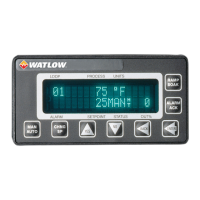CLS200 Series User’s Guide
Chapter 3: Using CLS200
61
Restore Automatic Control After a Sensor Failure
This feature returns a loop to automatic control after a failed thermocouple is repaired. To enable this
feature:
• Choose a digital input for the RESTORE PID DIGIN parameter in the SETUP LOOP
CONTROL PARAMS menu.
• Connect the digital input to the dc common terminal on the controller.
Process Alarms
The CLS200 has four process alarms, each of which you can configure separately for each loop:
• Low process alarm
• High process alarm
• Low deviation alarm
• High deviation alarm
Setting Up Alarms
To set up an alarm:
• Set the alarm setpoint
• Set the alarm type
• Choose an output, if desired
• Set the alarm deadband
• Set an alarm delay, if desired
The setpoints, deviation alarm values, and deadband all use the same decimal format as the loop’s
process variable.
What Happens If a Process Alarm Occurs?
If a process alarm occurs, the controller does the following:
• Shows an alarm code on the display. (See Alarm Displays on page 53.)
• Activates the global alarm output. (See Global Alarm on page 63.)
• Activates the digital output that is assigned to the process alarm (if applicable). The digital
output remains active until the process variable returns within the corresponding limit and
deadband; the alarm output deactivates when the process returns to normal.
Process Alarm Outputs
Any digital output that is not used as a control output can be assigned to one or more process
alarms.
The controller activates the output if any alarm assigned to the output is active. Process alarm
outputs are non-latching—that is, the output is deactivated when the process returns to normal,
whether or not the alarm has been acknowledged.
Specify the active state of process alarm outputs at the DIG OUT POLARITY ON ALARM setting in
the SETUP GLOBAL PARAMETERS.

